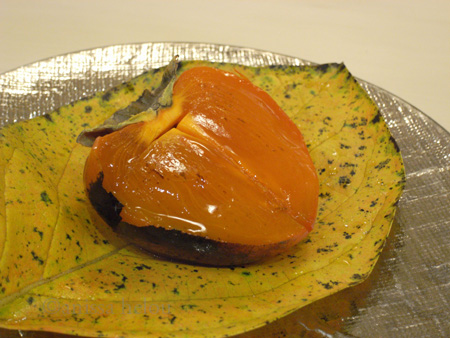6 Oct

It is nearly two years since I have been back in Lebanon and the first thing that struck me when I got home to my mother was how much better all the fruit tasted from that I buy in the Lebanese shops in London. I had asked my mother to buy me all that was in season and being the wonderful mother she is, she stocked up on custard apples, jujube, fresh dates and pistachios, khaki, pomegranates and peaches, all of which I adore and all of which I buy in London when they come into season. However, none taste as good there as they do here. Perhaps it is because of the long absence. Or more to the point, perhaps it is because of the time the fruit spend in transit. It could also be the quality. What is exported is possibly not as good as what is sold locally. All I can say is that I will make sure from now on that I go to Lebanon when my favourite fruit is in season. I missed the figs this year. My mother said something very interesting when I asked why she hadn’t bought any. Apparently, they turn sour as soon as it rains. The word in Arabic is ‘bi hammdo’. I never knew that and next year, I’ll be there before any rain spoils the figs!
4 Jan

Also known as kaki or Sharon fruit, and one of my favourite winter fruit. It is in full season now and as it happens, I am staying with a great friend who has a tree laden with them. So, every morning I go down in my dressing gown and slippers to eat a few picked straight off the tree. It reminds me of my childhood Syrian summers when we stayed with my aunt whose house was surrounded by jujube, pomegranate and fig trees to name but a few. One thing I learned this morning as I was reading through the wikipedia entry for persimmons is that the species of trees bearing the fruit belongs to the ebony wood family, another favourite — I once wanted to do my kitchen in solid ebony until a friend who was in the wood business told me that the trees are endangered! Fortunately, persimmons are not and those on my friend’s tree are fuyu whereas most of the ones I used to eat in Lebanon are Hachiya which are very precious when dried.
7 May
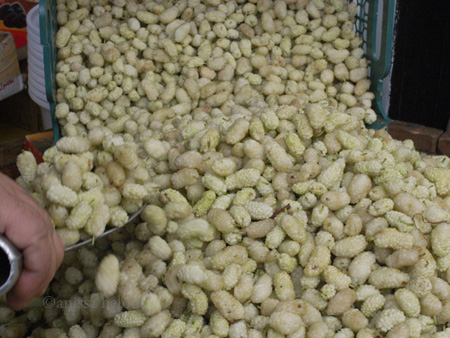
April/May is probably the nicest time to be in the Middle East. Not only because of the weather which is just fabulous (sunny and not too hot) but also because of the profusion of seasonal produce. I was in Tehran recently and the produce I saw in the different markets I went to was simply amazing. Our farmers markets don’t even come close. Here are a couple of pictures of the first white mulberries of the season for sale in Tajrish market. I bought half a kilo but I have to say they were not so sweet. Still too early in the season. However, when they are good, they are simply amazing. I can never decide which I like better: the white or the red ones. I guess both are fabulous. And recently, when I was in the Emirates, I found really long red mulberries but I am not sure if those are still called mulberries. Perhaps you can help. Should have taken a picture but I was filming and didn’t get the opportunity.
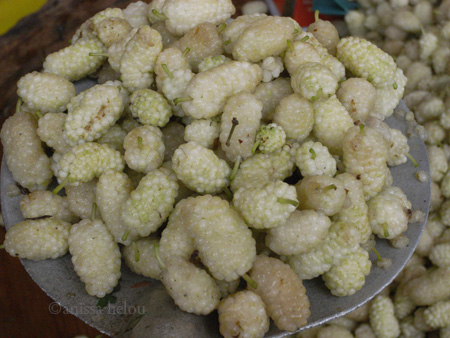
6 Dec
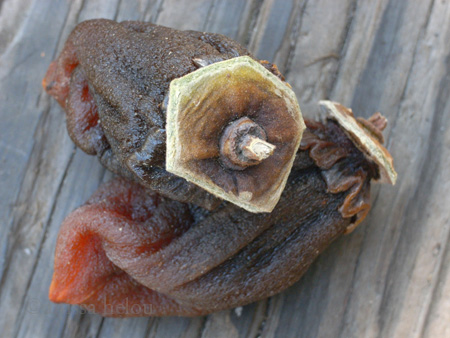
So, my trip to the US has come to an end. I am happy to be home although I am already missing the sunshine of the Bay Area and LA and the bustling streets of NYC. It has been a great trip. The World of Flavors conference was wonderful, my road trip to LA divine and my innumerable meals in restaurants and at friends totally delicious, except for one or two disappointments, including a dinner at Saison which I was looking forward to but it failed to live up to expectations. Still, one or two indifferent meals out of more than 30 (the other was at Tacubaya) is a low percentage. And to cap a very successful trip, I discovered a new foodstuff.
Shortly after WOF, I went back up to Napa to hang out with my wonderful friend Toni Sagakuchi who teaches at the CIA and as I sat in her drawing room, I became fascinated by what I thought was a decorative installation. Lots of funny, dark wrinkly objects hanging indvidually next to each other on a rack — the picture below is of another installation made by her charming husband, Chad, at the Hess winery where he is the chef.
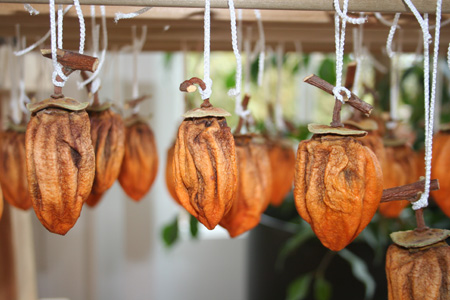
Toni is originally Japanese and the installation had a Japanesy feel to it although it didn’t quite look inanimate, not that the objects were moving but they didn’t look plastic either. I kept looking at them wondering what they were until it hit me that they were edible, hung there to dry. And as I looked more closely, I realised they were persimmons or khaki as they are known both in Japan and in Lebanon. We were in full khaki season and I had also been eating them both in Lebanon and Syria (where they serve them in restaurants with clotted cream at the end of the meal).
Here is a shot of a friend’s harvest in Ain Zhalta in the Lebanese mountains and even though the khakis in the pictures go mushy, they are not the ones that are dried.
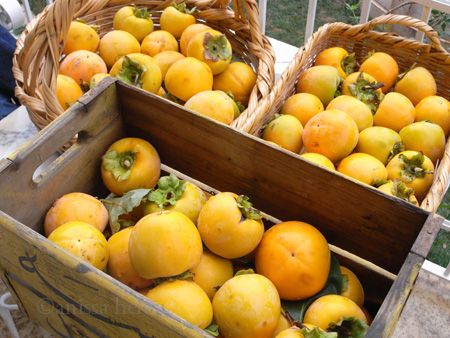
Only the Hachiya persimmons (with a pointed end) in the picture below, taken at the farmers market in Oakland, are dried.
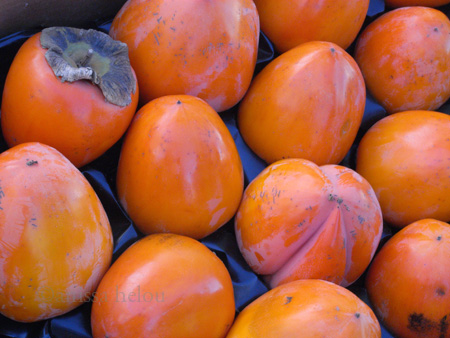
By then, I was very intrigued. I had never seen dried persimmons before, nor had tasted them. So, I asked Toni to tell me about them and she said that she had learned how to dry them from her Japanese parents — drying persimmons is a typical Japanese tradition and the process is delicate and long; each fruit has to be tied and hung individually, and then gently massaged every day. And all the fruit she had hanging in her drawing room had come from a tree in her garden.
At a subsequent dinner with Harold McGee, he told me more about them and sent me this useful link explaining all about the method http://ceplacer.ucdavis.edu/Eat_Local,_Start_Now/Hoshigaki.htm
Toni then gave me some to taste (and some to take away), and it is incredible how flavourful the dried fruit is, and what a lovely texture it has. I am now waiting for the fruit to be covered by a white sugary powder which is the last stage.
Later in my trip, I was served this exquisite khaki at the end of my meal at Urasawa. Sadly, I was not able to discuss drying them with Hiro, the fabulous chef/owner. The counter was full and it was getting late. It didn’t matter really. What mattered was that the fruit was served at its most perfect stage of ripeness. Not too mushy for it to start losing its flavour, nor under ripe which would have made it dry on the tongue. In fact, my whole dinner at Urasawa was perfect except for the deeply embarassing moment when my card was declined, and not because of lack of funds, just because my banker had decided in all his wisdom to switch these to a fixed deposit account!!
